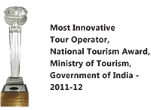The Syrian Christians of Kerala – Harmony in History and Culture
One of the gorgeous destinations that Adventure River Cruises offers for you to explore is Kerala. Find yourself, as you cruise down the rivers and backwaters of God’s Own Country, and taste the local culture for yourself. One of the communities that you will encounter are the Syrian Christians of Kerala. If you thought that Christianity came to India with the white colonialists, you can’t be blamed. A commonly misunderstood idea, most people do not know just how long this faith has been around.
Though it is hotly debated by historians, it is said that the inhabitants of India were first introduced to Christendom in CE. 52, by Saint Thomas the Apostle when he landed in Maliankara, near Cranganore – known today as Kodungallur. Preaching the gospel, he travelled across the length and breadth of Kerala, and managed to convert a sizeable number of the locals, many of them from the more literate upper-caste Nambudiris – who were Brahmans. He continued his journey as he set up churches in seven spots across the state. Known as Syrian Christians, because they use Syriac (a classical form of Aramaic) liturgy in their church services, they are also called Nasranis, because they are followers of Jesus the Nazarene.
The survival and spread of Christianity in Kerala is due to the adaptability in melding with local traditions, to form a character that became indigenous. In fact, as opposed to any witch hunts, the Syrian Christians were socially ranked right after the Brahmans, and were considered equal to the Nayars. They were also allowed to thrive by the tolerance and benevolence of the rulers of Cochin, Malabar, and Travancore. They donated money and land to help facilitate building churches, and even gave the Nasranis special trade privileges. The Syrian Christians managed to stay independent for a long time and received their bishops from the Eastern Orthodox Church in Antioch, Syria.
This continued until the arrival of the Portugese in 1498, who, through guile and organisational skills, established the Roman Catholic Church as the main church of the coast of Malabar, as Kerala was known then. It was only much later, when the Portugese influence was deciding in the early 17th century, that the Syrian Christian Orthodox tradition was reaffirmed. They stayed true to their Jewish and Hebraic origins, while blending Keralite customs and culture into their lifestyle. They also separate themselves from Western Christians as they follow Marthomayude Margavum Vazhipatum, or ‘The Way and Traditions of St. Thomas’, saying that while the Western Christians follow Peter, they follow Thomas. However, being the oldest order of the faith in India, and because Hindu kingdoms were staunchly casteist, the Syrian Christians have a strong sense of tradition and caste. Consequently, they share numerous social and cultural customs with their neighbours.
They follow customs such as observing the practise of dowry, decorating with rice flowers, the observance of 41 day mourning period after a death in the family. Many of the practises that follow the birth of a child are also observed, such as the ceremonious first feeding of the newborn a mixture of powdered gold and honey, the Chorunnu ceremony – a solemn rice feeding, the arannyaanum ceremony – the tying of an amulet around the waist. The practises they follow tol deal with purification and related practises are rooted in Jewish tradition, and adhere to Mosaic laws.
With names like Yohannan or John, Mathai or Mathew, and Soshamma or Susanna, Mariamma or Mary, they mostly stick to Biblical names of Hebraic origin. There are some Middle Eastern names, which are also used in parts of Armenia and Greece, that are used. Some examples of these would be Kurian, Kuriakose, Varkey, Paulose, etc. They have specific naming conventions, some of which are similar to Sephardic Jews, especially those concerning the naming of children. Their names consist of their first name, the father’s name, and the surname or family name.
As all religious groups do, the Syrian Christians evolved unique art forms. Substantially influenced by local culture, which was blended into Christian traditions to make their own dances and folk songs. The most popular, and indeed famous, dance performance of the Syrian Christians is the
The word margam holds the meaning of ‘path’, and taking inspiration from Kalaripayattu and Sangamkali, the Margamkali is performed by both male and female dancers, though it is now mostly performed by women. Dancing around a lit oil lamp, the dancers represent the apostles of Christ, who is symbolised by the lamp. The songs are sung in Malayalam, and tell the tale of the activities and martyrdom of Saint Thomas. The Margamkali is also very different from other dance forms in Kerala, because there is no musical accompaniment, only the songs and dances of the performers. You can see performances as you cruise down the rivers and explore the countryside.
On our cruises, you can explore villages that were hubs of the spice trade as far as a 1,000 years ago, where you can see a unique blend of European and Keralite architecture. We also take you through artist villages that are renown for metal and brass craft, where you can interact with the artisans and watch them practise their craft.





















Leave a Reply
You must be logged in to post a comment.